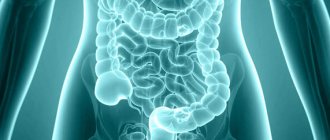Heartburn, nausea, dizziness are sensations familiar to many, but few know what such ailments may signal. The most common opinion is that nausea occurs after overeating, during pregnancy, and during motion sickness in transport. These symptoms are not enough to accurately diagnose your health; you can only make the assumption that they are associated with diseases of the digestive system.
It is curious that in women such symptoms occur 3-4 times more often than in men. But in any case, ignoring signals that last for several hours or self-medicating is dangerous.
Nausea is a protective reaction of the body, signaling malfunctions in the functioning of organs and systems. This serious symptom warns you to seek medical help.
Causes of headaches, nausea and dizziness
Headache and dizziness are often accompanied by nausea. The centers of these sensations are located close to each other in the brain. Acute pain often leads to loss of balance, loss of coordination, and nausea. It is important to determine what caused these symptoms - information will allow you to prescribe the correct and most effective treatment.
Migraine
Migraine is an acute headache that occurs in attacks and occurs without a specific reason. Its characteristic feature is the “migraine aura”, which is felt several hours before the onset. Most patients who regularly suffer from migraines can determine the imminent onset of an attack by characteristic precursor symptoms:
- nausea, vomiting;
- dizziness, sudden loss of balance;
- increased sensitivity to bright light and sounds;
- in some cases - speech impairment, memory loss.
If you often feel dizzy, dizzy, or feel nauseous, this may indicate a migraine. The disease is often hereditary, and in some patients it occurs after injuries and bruises. For treatment, specific drugs are prescribed to strengthen blood vessels and relieve acute pain.
Metabolic disorders
Symptoms such as headache, nausea, dizziness can occur with systemic diseases. They are accompanied by other symptoms or occur independently. A more detailed diagnosis may reveal the following disorders:
- diabetes;
- pathologies of the thyroid gland, including its inflammatory diseases and neoplasms;
- diseases of the stomach and intestines: ulcers, inflammation of the mucous membrane.
A thorough examination is important for prescribing the correct treatment. Taking medications that only relieve symptoms will not help you feel better, but will only make the situation worse. If a patient often has a headache, and dizziness and nausea appear as accompanying symptoms, the cause may lie in dysfunction of the internal organs.
Hearing diseases
Diseases of the inner ear are accompanied by severe headaches, nausea, dizziness, and deterioration of well-being. They pose a great danger because they progress quickly. If treatment is incorrect or untimely, there is a risk of complete hearing loss.
- Meniere's disease is a specific pathology in which an increased amount of endolymph is produced in the inner ear. The liquid puts pressure on the structures of the hearing organ, which is manifested by nausea, headache, dizziness, and impaired coordination of movements. Characteristic symptoms are a sharp decrease in hearing in one or both ears, auditory hallucinations.
- Vestibular neuritis is inflammation of the vestibular nerve. Most often, the disease is of viral origin, less often associated with a bacterial infection or allergy. Neuritis is manifested by an acute headache, but there is no hearing impairment.
- Labyrinthitis is an inflammation of the inner ear. The disease is a complication of otitis media and develops if it is not treated in a timely manner. Labyrinthitis causes symptoms such as nausea, dizziness, weakness, headache, as well as hearing loss and tinnitus. Purulent discharge from the ear canal may be observed.
- A perilymphatic fistula is a damage to the septum between the middle and inner ear. The liquid contents of the inner ear penetrate into the middle section. The condition is very dangerous and can lead to unilateral hearing loss.
It is important to understand that diseases of the inner ear are not always accompanied by hearing impairment. Often the patient simply has a headache and dizziness, nausea, weakness and fever. When diagnosing, one should not exclude the possibility of damage to the organ of hearing, even if there are no typical complaints of pain and tinnitus.
Arterial hypertension
High blood pressure is a common disorder for both older and younger people. Its causes include weakness of blood vessels, a decrease in the strength and elasticity of their walls. The disease is chronic and manifests itself in attacks. At home, you can always measure blood pressure using a tonometer if the following symptoms occur:
- nausea, vomiting, dizziness, headache;
- deterioration in coordination of movements;
- redness of the skin and mucous membranes;
- heart rhythm disturbance.
Attacks of arterial hypertension can be triggered by stress, high tension, physical exertion, as well as sudden changes in weather conditions. If they are moderate, they go away after a long rest. If your health suddenly deteriorates, it is important to immediately seek medical help, since hypertension in combination with weakness of the vascular walls can cause a stroke.
Vertebro-basilar insufficiency
Vertebro-basilar insufficiency is a dangerous syndrome in which brain function is disrupted due to insufficient blood flow in important arteries (basilar or vertebral). Blood does not flow to the nerve cells, so they cannot function normally.
Vertebrobasilar insufficiency is manifested by the following symptoms:
- headache, nausea, dizziness, weakness;
- short periods of vision loss, the appearance of black dots and circles before the eyes;
- sudden hearing loss, tinnitus;
- constant weakness and fatigue, possible fainting.
The disease can be congenital or acquired, and is often hereditary. Its causes in adulthood include damage to the cervical spine, atherosclerosis, diabetes mellitus, and inflammatory vascular pathologies. An accurate diagnosis can only be made on the basis of MRI or CT data, since the clinical picture resembles other diseases that are accompanied by cerebral circulation disorders.
Other reasons
The causes of headaches, dizziness, nausea and weakness can be associated with various conditions and diseases. These symptoms occur in diseases of the internal organs, endocrine and cardiovascular systems. They can indicate a huge number of disorders, which can only be distinguished based on the results of diagnostic data:
- osteochondrosis of the cervical spine - a disease of intervertebral cartilage, in which they are destroyed, deformed and compress the blood vessels carrying blood to the brain;
- increased intracranial pressure - this value cannot be measured accurately, but headache, dizziness and nausea are typical symptoms;
- Tension headache is one of the most common causes and is associated with stress, physical fatigue, and prolonged exposure of the neck to an uncomfortable position;
- The cause of dizziness, nausea, and headaches in women can be early pregnancy.
Doctors at the Clinical Institute of the Brain warn that such symptoms are a reason for a more detailed examination. They may not occur frequently in a healthy person, even due to high fatigue and tension. Nausea, vomiting, dizziness, headache and weakness may indicate hidden pathologies of internal organs that progress and cause dangerous complications.
Nausea, vomiting, dizziness - ominous signals from the body
Periodic burning and heat behind the sternum, moving up the esophagus, does not occur out of nowhere: it most often occurs with gastrointestinal diseases and high acidity. An unbalanced diet, abuse of carbonated and alcoholic drinks, heavy and unhealthy foods, and fast food damage the gastric mucosa. It becomes thinner, irritation appears, and protective capabilities are impaired. External manifestations of such signs are heartburn and nausea.
Heartburn indicates that particles of undigested food along with stomach acid penetrate the esophagus. It does not withstand the aggressive effects of the gastric environment. Some medications, negative emotions, infectious diseases, and smoking aggravate the problem. Sometimes heartburn occurs from physical exertion, especially when bending over.
Common signs:
- Bitter taste in the mouth;
- Bursting sensations in the epigastric region;
- Painful symptoms;
- Flatulence.
Heartburn often appears when overeating, if the victim takes a lying position. Those who often eat lunch on the go, do not chew food completely, and constantly overeat suffer from an unpleasant symptom. Spicy, fried and fatty foods, sweets and spices provoke malaise. Heartburn not only worsens the quality of life - in some cases it provokes bleeding, ulcers, erosions, and stenosis of the esophagus.
There are 2 types of heartburn:
- The false appearance has nothing to do with food, persists for quite a long time, does not go away after using antacids, and radiates to the side, back, and stomach. These are signs of heart failure.
- The true type occurs after eating: a burning sensation in the chest moves along the esophagus, accompanied by flatulence, especially in a supine position.
With regular heartburn (every other day), you can think about damage to the esophagus, gastritis, or peptic ulcer. Symptomatic treatment does not give stable results; it is necessary to treat the underlying disease.
Dizziness (loss of coordination) also comes in two types: central (diseases of the brain) and peripheral (damage to the inner ear and vestibular nerve).
Nausea and vomiting with high blood pressure is a reflex calling for the evacuation of stomach contents, due to local and cerebral causes. In the first case, it is intoxication and intestinal infections that irritate the gastrointestinal mucosa with toxins. Causes of a cerebral nature arise due to a lack of oxygen and nutrients entering the brain.
Diagnostic methods
To understand why the patient feels sick, sick, and dizzy, a full examination should be performed. Various techniques are aimed at identifying hidden pathologies that require specific treatment. During the initial examination, the doctor collects medical history data. It is important to describe in as much detail as possible under what conditions the headache begins, how often attacks occur and how long they last. To confirm the diagnosis, the following techniques may be needed:
- first of all, measuring blood pressure; the patient is also recommended to monitor it at home;
- tests to check balance, including the Romberg test (deterioration in coordination of movements is manifested by staggering in a standing position, with eyes closed, feet shifted and straight arms extended forward);
- a general blood test will indicate inflammatory processes, as well as various types of anemia;
- blood test for glucose levels;
- heart examination, which includes ultrasound diagnostics and electrocardiogram;
- tests to assess hearing and visual acuity;
- X-ray of the cervical spine;
- study of blood flow in the vessels of the neck and head - a contrast agent is used for this;
- electroencephalography - analysis of the bioelectrical activity of brain cells;
- computer or magnetic resonance imaging is the most accurate, informative way to examine the brain, including soft tissues and blood vessels, which allows you to obtain a complete image of the affected area.
At the Clinical Institute of the Brain, you can undergo a complete diagnosis and determine the causes of nausea, dizziness, and headaches. The regimen is selected individually, based on the results of the initial examination of the patient. An experienced doctor will prescribe only those studies and tests that will determine the nature of the pathology. This is the most important stage in solving the problem, since the diagnostic results allow you to select the most effective treatment regimen.
Treatment methods
It is important to start treatment promptly if attacks occur frequently or are of high intensity. The regimen includes several steps aimed at eliminating the cause and symptoms of headaches and dizziness.
- The first stage is relief of an attack of acute pain. For this purpose, analgesics, antiemetics, and antihistamines are prescribed.
- The second stage involves systemic treatment of the underlying cause of the attacks. The doctor will select a suitable regimen to support the functioning of the gastrointestinal tract, heart and blood vessels, and endocrine glands.
- For pathologies of the cervical spine, non-drug methods are effective. Treatment methods such as massage, gymnastics, and physiotherapy may be prescribed.
- For migraines, conventional painkillers do not provide relief. After confirming the diagnosis, the doctor will prescribe medications from the triptan group (sumatriptan).
- To restore balance, a set of exercises that can be performed at home is effective. It includes turning the head while stopping the gaze at a certain point, walking with eyes closed, and standing on one leg.
If you have a headache, feel sick, feel dizzy, or feel weak, you should definitely consult a doctor and start treating the problem. The Clinical Brain Institute offers comprehensive programs for diagnosing and treating headaches. Here you have the opportunity to undergo a full examination by experienced specialists and receive the most effective recommendations. Treatment takes place under the full supervision of general and specialized doctors, using new techniques and modern equipment.
Prevention of such disorders
Leaving ominous signs unattended is dangerous: hydrochloric acid, released during spasms, systematically irritates the walls of the stomach, causing gastritis and peptic ulcers.
The doctor may recommend physical therapy and massage, acupuncture and manual therapy sessions.
A prerequisite for normalizing the functioning of the gastrointestinal tract is adherence to the principles of a healthy diet:
- Exclusion from the diet of spicy, fatty and fried foods;
- Control of the quantity and quality of food consumed;
- Dinner - at least 4 hours before bedtime;
- After eating - a quiet rest, without tight clothing that compresses the esophagus;
- Eating in a pleasant environment, with thorough chewing.
Yes, nausea, vomiting and dizziness are unpleasant symptoms, but they protect our health, so we should not neglect them or self-medicate. Perhaps these signs indicate the progression of dangerous diseases that require complex therapy according to an individual regimen.










